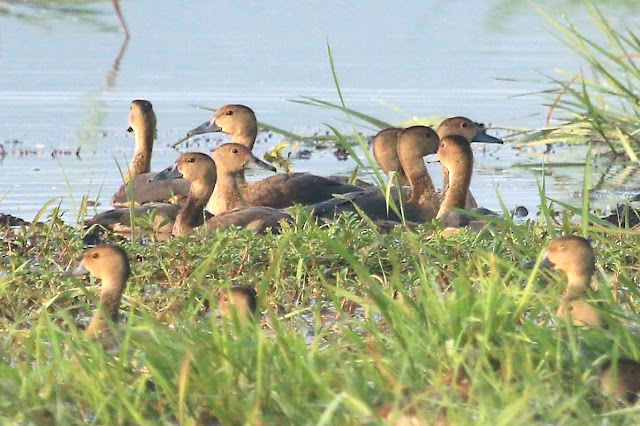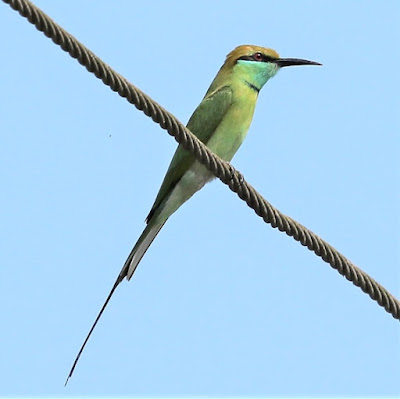Tuesday 8 November 2022
We stopped by a small chapel next to a flooded area (above) that, as Omkar explained, was a ‘tank’ holding
water for the rice paddies on the other side of the road.
This functional use means that the wetland is effectively protected,
even though it has no legal status as a wildlife site. As can be seen from the photo above, the place was full of egrets.
But there was a lot, lot more.
Most noticeably, a Common Kingfisher (the same species as in the UK) flew in and perched on a convenient stump nearby. The ‘take-off’
image (below) is blurred but has a nice sense of movement. Unlike the previous brackish wetlands
that we had been to, this was a wholly freshwater site – which seemed to
attract a wider range of bird species.
 |
| Common Kingfisher - take off! |
Waterfowl included many Lesser Whistling Ducks, the most widespread of the two Dendrocygna species that are found in India (the other being Fulvous Whistling Duck). Lesser Whistling Ducks have a wide range in Asia, although they are not found north of the Himalayas. Their greyish-buff head and smaller size separates them from the much less common Fulvous Whistling Duck.
 |
| Lesser Whistling Ducks - Maina-Curtorim |
Other water birds here included Pygmy Cotton Goose and Pheasant-tailed Jacana. The jacana was distant, but I had good views through the ‘scope of its black and white head poking up from the vegetation. No pheasant tail, unfortunately, as these only appear in the breeding season. Omkar said that this species is rare here at this time of year, although the map in my field guide (Grimmett and Inskipp, 2020) shows the species as being resident over almost the whole of India.
We walked for a short distance along the road, ‘scoping the wetland and occasionally dodging passing cattle and mopeds - not easy, as there was barbed wire close to both sides of the narrow tarmac strip. The remining new species here (for the trip) were all familiar from European wetlands: Dabchick, Eurasian Coot, Common Moorhen, Pintail, Garganey, Black-winged Stilt and Glossy Ibis, about 20 of which flew in over the paddyfields. A nearby clump of mature trees contained Pied Cuckoo and Scaly-breasted Munias - more exotic! We walked out along a track that zig-zagged across the paddyfields, some of which were being harvested. The rice lay drying on sheets laid across the track.
 |
| On the paddyfields at Maina-Curtorim |
%20Curtorim%208.11.22.JPG) |
| Rice harvesting at Maina-Curtorim |
While the paddyfields were generally poor for photography this Indian Pond Heron (below) was pleasingly obliging. They are probably well-used to being around people; the fields here are a place of work for the local villagers and the pond herons make the most of it, foraging for food in the muddy areas where the rice has recently been cut. When seen like this, Indian Pond Herons are reminiscent of the closely related Squacco Heron, but in a previous blog post (Siolim Fields) I included a photograph of one in flight which shows the vividly contrasting white wings that are usually hidden from view. ‘They are like two different birds in one,’ said Omkar.
 |
| Indian Pond Heron - Maina-Curtorim |
A female Marsh Harrier flew over, which heralded the arrival of a flurry of new species: Oriental Turtle Dove; Paddyfield Warbler, Paddyfield Pipit, River Tern (three flying distantly) and Small Pratincole (five flying away in the distance followed by a couple that flew right over our heads). Paddyfield Warbler is similar to a few other of the Indian Acrocephalus warblers, notably the common Blyth's Reed Warbler; the prominent supercilium is a key identification feature. It is a winter visitor to Goa. By contrast, Paddyfield Pipit is a widespread resident species; it is clearly smaller than either Blyth’s or Richard’s Pipits. The River Terns appeared to me as three large terns (bigger than Common) with light-coloured bills - actually yellow. The Small Pratincoles had the distinctively-pointed pratincole wings, which showed well as they zoomed over us. By now I was quite ready to call it a morning and head for the car but Omkar pushed on, reassuring me that it was ‘not far before we will turn around’.
The
paddyfields kept on delivering birds: Zitting Cisticolas, one of which perched
nicely on a grass stem; Common Snipe, several of which were flushed but none could
be turned into Pin-tailed Snipe (which has a different flight pattern and a
marginally shorter bill); Bluethroat, also nicely perched; another Asian Openbill (flushed
out of the grassland); and a supporting cast of Plain Prinia, Long-tailed
Shrike, Yellow Wagtails and Wire-tailed Swallow. And my first Pied Bushchat, a female. The same genus as Stonechat (Saxicola), this is a widespread but
variable Asian species. Two swallows
flew overhead, one a familiar Barn Swallow, the other my first Streak-throated
Swallow, a species that is restricted to the Indian subcontinent. Some authorities group it with the similar
Fairy Martin.
 |
| White-rumped Munia - Maina-Curtorim |
With that, we turned around and retraced our steps along the zig-zag track, stepping over the piles of harvested rice. Back at the road, we had a good view of a perched White-rumped Munia (above) on a spiky shrub. Like most of the pictures that I’ve seen of this species, the white rump isn’t visible, so it is an odd character to highlight in vernacular name. Very few finches (Fringillidae) descend from the Himalayas into peninsular India. Instead, their niche seems to be filled by the Estrildidae – the waxbills – which are also characteristic of Africa and Australasia. White-rumped Munia is found across most of south-east Asia and China, although oddly absent from large parts of the north and centre of India. We piled back into the taxi; a short drive took us to another wetland overlook a short distance to the west. This had less avian activity, but was enlivened by a flying Shikra, looking like a paler version of a Sparrowhawk - the first of the trip.
 |
| Crested Serpent Eagle - Maina-Curtorim |
We were just heading off when Omkar signalled Prakash to stop urgently. Perched in a tree, and hiding its head in a somewhat bashful manner, was a Crested Serpent Eagle (above). Its black and white crest was just visible, albeit folded down. This eagle is widespread across India, south east Asia, China and Indonesia, and is quite variable – the HBW/Birdlife Checklist identifying 21 subspecies. Apart from the almost ubiquitous kites, raptors had been relatively scarce on the trip so far, so this was good to see. With that, we headed to our last stop of the morning. The drive took us past Curtorim Lake, which Omkar said had once been good for birds but which had now been ‘improved’ for visitors, with the addition of hard edges and a loss of vegetation and wildlife. We parked on the dam of the nearby Communidade Lake.
 |
| Birding at Communidade Lake |
There was a scatter of waterfowl on the lake, the best of which were more Cotton Pygmy Geese, but the real highlight was closer views of the Asian Green Bee-eaters that were zipping around over the water. One posed nicely on a nearby wire (below). You cannot have too many pictures of bee-eaters.
 |
| Asian Green Bee-eater - Communidade Lake |
After exhausting the lake’s rather limited birding possibilities, we drove back to Margao and reunited Omkar with his vehicle. Prakash then drive us back up the dual carriageway to Arpora. I was so washed out that I fell asleep for the first part of this drive – no mean feat given the bumpy road. I was happy and relieved when he pulled up outside the Marinha Dourada. I spent the afternoon recovering from my stomach bug (with a suitably large range of non-alcoholic fluids) while Richard finally tracked down the elusive Mr Veen and managed to change our pounds to rupees - at the cost of a long conversation. Richard then had an exploratory walk up Baga Hill, and came back full of excitement about its birding possibilities. We resolved to return for a longer visit the following afternoon when I hoped that I would be more mobile.
Which is indeed what happened. Adequate rest and an early night worked wonders. Which was just as well, because we had a boat trip to look forward to.
To be continued ...




No comments:
Post a Comment